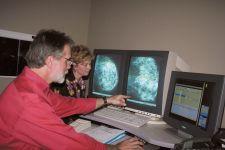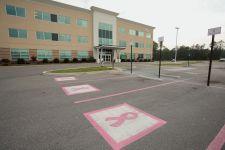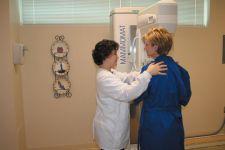
Part of Battlefield's winning team, including Barbara Marshall (front row right) and John Nelson, M.D. (back row far right)
Sporting a name like Battlefield Imaging, which was derived from a prominent and bloody Civil War campaign that happened nearby 144 years ago, it’s almost ironic that the Ringgold, GA-based outpatient imaging center is so dedicated to cooperation, customer service and harmony.
Tucked in the northwest corner of Georgia along the Tennessee border, less than 10 minutes from Chattanooga, and flanked by Civil War monuments and the Chickamauga-Chattanooga National Military Park, Battlefield Imaging isn’t interested in satisfied customers. Honestly. Instead, it strives for something more.
“We do not ever want a satisfied customer,” said Barbara Marshall, R.T., administrative director. “We strive for loyal customers who are promoters of our center and the services we offer. We continue to seek ways to make the experience of the visit the best the customer has ever afforded in a healthcare setting. From pagers at the front desk, to how the staff interacts with every customer from scheduling to completion of exam, customer interaction with the radiologist, to the nutrition café, we continually strive for excellence.
“We’re always trying to seek ways to be different to give the customer that ultimate experience,” Marshall continued. That includes the service and attention provided as well as the “cutting-edge” technology used. “Customers expect a certain level of service,” she added. “We have to go above and beyond those expectations. Tech is tech. But it’s all about the service. What makes a difference is the experience with the person doing the X-ray.”
John Nelson, M.D., Battlefield’s medical director, agreed. It involves listening to the patient, understanding his or her needs and wants and addressing them, empowering the patient without rushing them, he noted.
“We give a lot of individual effort,” Nelson told Outpatient Care Technology. “We try to make them feel like they’re the only concern we have at the moment. Either you have that or you don’t. We’ve hired engaging, personable people who are good communicators. We provide a service – efficiently, cost effectively and painlessly, if possible, scheduling alternatives. The important driver is the individual attention the patient gets. Loyal customers come back to you. I don’t go somewhere to be satisfied. I expect that as a basic part of service. You go above and beyond that so they come back.”
Such customer service manifests itself in several ways. One involves making sure patients are informed, according to Marshall.
“Five-minute delays are too long,” she said. “We’ve found that informed customers are happy customers.” And every customer is personally walked from their treatment room to the nutrition café (converted from an old supply closet) and then out the door to his or her car with a “thank you for choosing Battlefield Imaging,” she added.
“When you have happy staff you have happy customers,” Marshall continued. “There’s nothing better than empowered employees. It’s fun watching them run the business, and it’s very enriching for me to watch them take care of their customers. We encourage them to be risk takers and to learn from mistakes. We tell them that there’s nothing we can’t fix. If a patient waits too long, for example, or they undergo an uncomfortable exam, our staff can give the patient a $10 Wal-Mart gift card. They can do it for whatever reason. We trust their judgment. It gives them an avenue for customer service. The only thing we ask is that they document who received the card and for what purpose for accounting and billing. We want to make sure everything stays legal.” So far, they’ve given out about $800 worth of gift cards through early September, she added.
What began nearly six years ago as a joint venture arrangement between Nelson’s Diagnostic Radiology Consultants (DRC) and Hutcheson Medical Center to operate an outpatient imaging facility offering open magnetic resonance imaging services in a strip mall has since mushroomed into a larger, standalone full-service diagnostic imaging facility. Battlefield Imaging is equipped with the latest multimodality digital imaging and paperless and wireless information technology and remains in close proximity to other related healthcare services with hallways and walkways linking to an ambulatory surgery center, breast imaging facility, cancer center and physician offices. It’s a one-stop shop in a competition-heavy market service area.
The competitive marketplace and the patient base helped motivate Dr. Nelson and his team to co-launch Battlefield Imaging alongside its onsite medical network. “Patients are frustrated going from doctor to doctor like ping-pong balls,” Dr. Nelson noted. “We wanted to bring the services to the patient. The patient is at the center or hub of our service wheel, and the spokes represent the services they get. This way the patient returns to the same facility for everything. They get comfortable and familiar with their surroundings.”
Such competitive foresight, coupled with a clear dedication to patient care and customer service prompted Outpatient Care Technology to recognize Battlefield Imaging with the 2007 Outpatient Excellence Award for Imaging Centers.
United Front
Back in 2001, Hutcheson Medical Center knew it needed to expand to reach the fastest-growing community on the far eastern part of its three-county service area with a surgery center, cancer center and physician offices.
“The radiology department at the hospital was busting at the seams and losing its most profitable patients, the outpatient imaging customer,” Dr. Nelson recalled. Meanwhile, an entrepreneurial group approached Hutcheson about partnering to launch an open MRI facility in the area. Dr. Nelson and his DRC group, which had been providing radiology services to the hospital since 1970, countered with their own proposal to work together, fending off any “outside threats” to Hutcheson’s market service area.
Within six months of opening the successful MRI center, Dr. Nelson said DRC and Hutcheson recognized that plans for an outpatient healthcare facility offering imaging, oncology and surgery services needed to be built. Hutcheson on the Parkway, named for the Battle of Chickamauga in September 1863 when the Confederates won and the Battle of Chattanooga in November 1863 when the Union won during the American Civil War, took shape.
Hutcheson financed the surgery center and cancer center, and invested 51 percent ownership in what would become Battlefield Imaging. DRC owned the remaining 49 percent, including a $5-million investment in technology, according to Dr. Nelson. “Both had to bite off a huge chunk and share the risks,” he said. “But we made sure we had a built-in referral base during our pro forma planning.” Battlefield Imaging also incorporated Hutcheson’s breast imaging center, which was supported by the 350-strong women in the hospital auxiliary. As a result, the Battlefield Auxiliary Breast Center, designed by cancer survivors to resemble a posh women’s lounge and spa, represents the diagnostic imaging component of Battlefield Imaging’s comprehensive breast services program that also includes surgery, radiation oncology and medical oncology as patients can be wheeled through the interconnected facilities for “seamless individualized care,” Dr. Nelson noted.
“We wanted the customer to be able to park out front in designated parking spaces which are strategically placed between the imaging, oncology and surgery centers,” Marshall said. “We wanted them to be able to come under one roof with familiar faces, who treat them as family as they travel the journey from discovery to recovery.”
Among the key areas of growth is breast MRI, according to Dr. Nelson. “We started in February with three in the first month,” he said. “Now we’re doing 35 to 40 breast MRs a month.”
Becoming an organization with digital imaging and electronic records capabilities such that the entire facility is filmless, paperless and wireless could have been more financially and operationally stressful for Battlefield Imaging than it was.
“We were able to build our facility from the ground up,” Dr. Nelson said, “so we didn’t have to retrofit the facility.” Because Battlefield Imaging is digital and filmless it doesn’t have any darkrooms and because it’s paperless and wireless it doesn’t require as much space for storage, he added. However, they didn’t accomplish this all at once but in incremental steps. For example, implement the digital imaging modalities, such as full-field digital mammography, then the fully integrated RIS/PACS and voice recognition system.
“You have to take it a step at a time,” Dr. Nelson said. “Otherwise, it’s like drinking from a fire hydrant.” He also did site visits and asked those facilities a lot of questions about mistakes and problems they encountered.
For Marshall, dealing with such change requires patience and humor. “The key challenge is change in the way we practice,” she said. “Entering data into the computer rather than writing it on a piece of paper takes less time and is more efficient overall. But I had to get the team to embrace that change. It was a sales job. I encouraged them to try it and tell me what works and what doesn’t. I had to be patient with them and listen, empower them and let them fall on their faces. We laughed about things that worked well and through things that were painful. But we just needed to be patient and have a sense of humor.”
Offering such a breadth of services with such a depth in advanced technology admittedly doesn’t come cheap but Battlefield Imaging chose a single vendor to handle much of the heavy lifting in the key modalities of digital mammo, high-field open MRI, PET/CT and RIS/PACS – Siemens Medical Solutions.
“In partnering with one vendor for the imaging side of the journey, we of course were able to receive very competitive pricing for such a large project,” Marshall said. “But more important than the pricing is the relationship that Siemens has afforded. They have never just installed and turned away. It has been a true partnership from the beginning to the present. In my years of experience this has been the first that a vendor has stood behind their promises and continually seeks opportunities for our center to be the best of class.”
Dr. Nelson admitted that they’re “very comfortable” with Siemens with whom they have a “strong relationship.” In fact, they negotiated “exceptional pricing” that helped Battlefield Imaging save roughly 18 percent in operating costs and overhead, he added.
Along with Siemens, Battlefield Imaging works with R2 unit for computer-aided detection for mammo, Invivo for MRI breast coils, Dynacad for MRI breast imaging, C.R. Bard for vacuum-assisted breast biopsy, E-Z-EM for CT dual-source injectors and Medrad for MRI injectors, Marshall and Dr. Nelson cited.
The return-on-investment for much of this equipment was about 18 months, Dr. Nelson said, save for the IT component that went live within the last year. Battlefield Imaging subleases Siemens’ syngo suite for fully integrated RIS/PACS, digital dictation and speech recognition from Specialty Networks, a venture owned by Nelson’s DRC group that leases syngo from Siemens. DRC launched Specialty Networks nearly four years ago to provide IT, professional interpretation and management services to a variety of facilities and medical specialties. One of Dr. Nelson’s partners, James Busch, M.D., has a fellowship in informatics and does IT research work for Siemens.
“We do a lot of beta testing for RIS and PACS products,” Dr. Nelson said. “It’s a working partnership with [Siemens]. Because of that relationship we were able to enjoy some competitive pricing.” Through this partnership, they’ve been able to centralize interpretation of studies and integrate multiple facilities transparently into a RIS/PACS network.
Open Book
One of the secrets to Battlefield Imaging’s success is not keeping secrets with the partners and staff during the monthly meetings.
“All financials are shared monthly with our people,” Dr. Nelson said. “Everyone is informed and eagerly encouraged to make suggestions and contributions to improving the bottom line.”
Such transparency began on the first day of operations, he continued. “We didn’t make money for the first six months in the beginning and they knew that, but they also saw when we were making money,” he added.
“We give them all the financials,” Marshall noted. “We tell them how much we pay per month in salary, for example. This is their business. So often we hide the part of whether we’re over or under budget, and the staff won’t know it until we have to cut two FTEs.”
With such empowering knowledge comes accountability and responsibility, according to Marshall. “When [the Deficit Reduction Act] hit and affected us I never talked about cutting anything but doing more with the same,” she said. “Not less. We have challenged them to find ways to reduce costs. For example, do you use everything in a pre-packaged tray? If not, what are alternatives? We constantly challenge them for ways to reduce costs. If they reduce costs and we can increase revenue, then we can get cutting edge equipment.”
Marshall admitted that they didn’t see the DRA as a “big deal.” They just posited that if they performed two additional MR exams a day or some alternative with equivalent revenue they could offset any reimbursement effects. “We know the value and reimbursement needed for an equitable return,” she noted. Every other Saturday they now offer MR services and are considering opening for a few hours on Sundays, she admitted. One side benefit to this is the increased availability of services for patients, which represents improved customer service. “Imaging has never had to be as customer-service-oriented as it is today,” she added. “It’s all about service.”
Another key strategy and tactic that contributes to Battlefield Imaging’s success is that staff members are multimodality trained. Technologists can operate an MRI unit for one patient and then move to the CT scanner next. “Having such a fluid and flexible staff eliminates hiccups,” Dr. Nelson said. “When one person steps up [and fills in] for someone one day they recognize that somebody will step up for them another day. I’m just a coach. They have to fight in the trenches. We are a team here with no silo mentality.”
Apparently, it’s working. Gross collections from January to August 2007 amounted to $5.6 million, Dr. Nelson revealed. That’s 3.7 percent higher than the same period last year, despite experiencing a 20 percent decline in reimbursement. Medicare and Medicaid account for roughly a third of Battlefield Imaging’s reimbursement pie. The rest comes from commercial insurance and private payers.
Thankfully, Battlefield Imaging also has seen a 24 percent increase in procedural volume, according to Marshall. “We’re working harder and making less money,” Dr. Nelson said laughing. “We’re trying to work smarter but we’re definitely working harder.”





 December 15, 2025
December 15, 2025 









